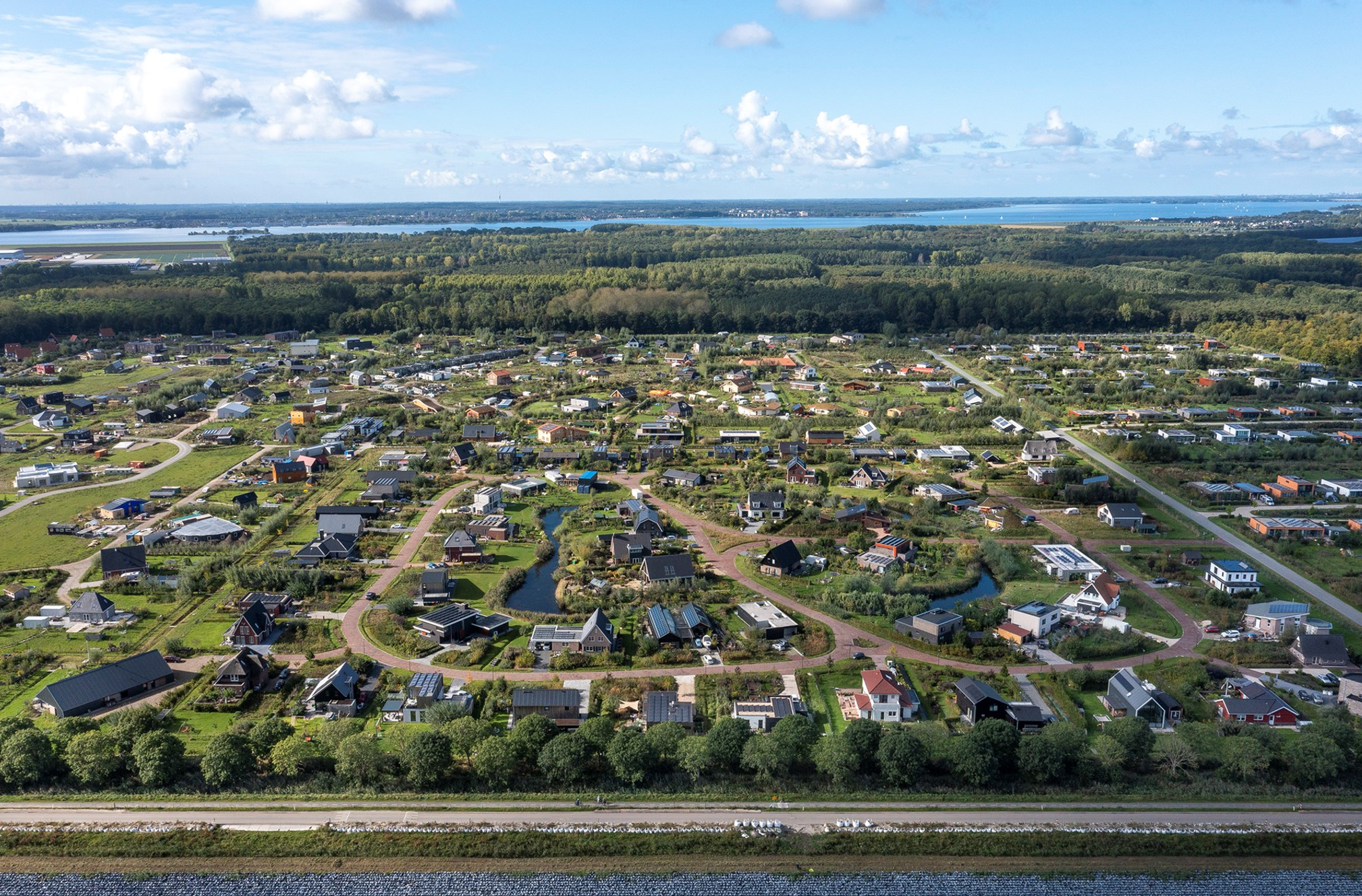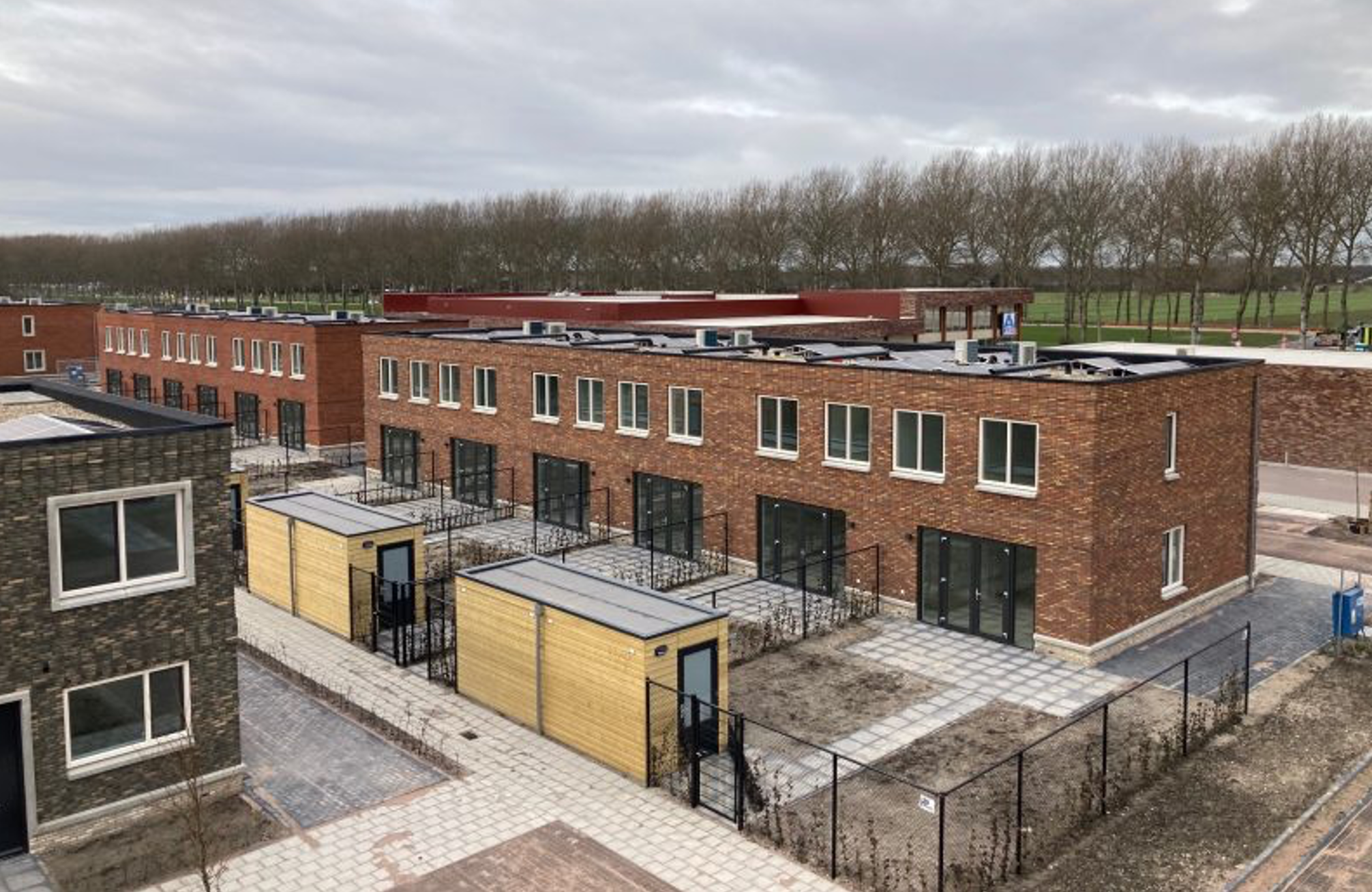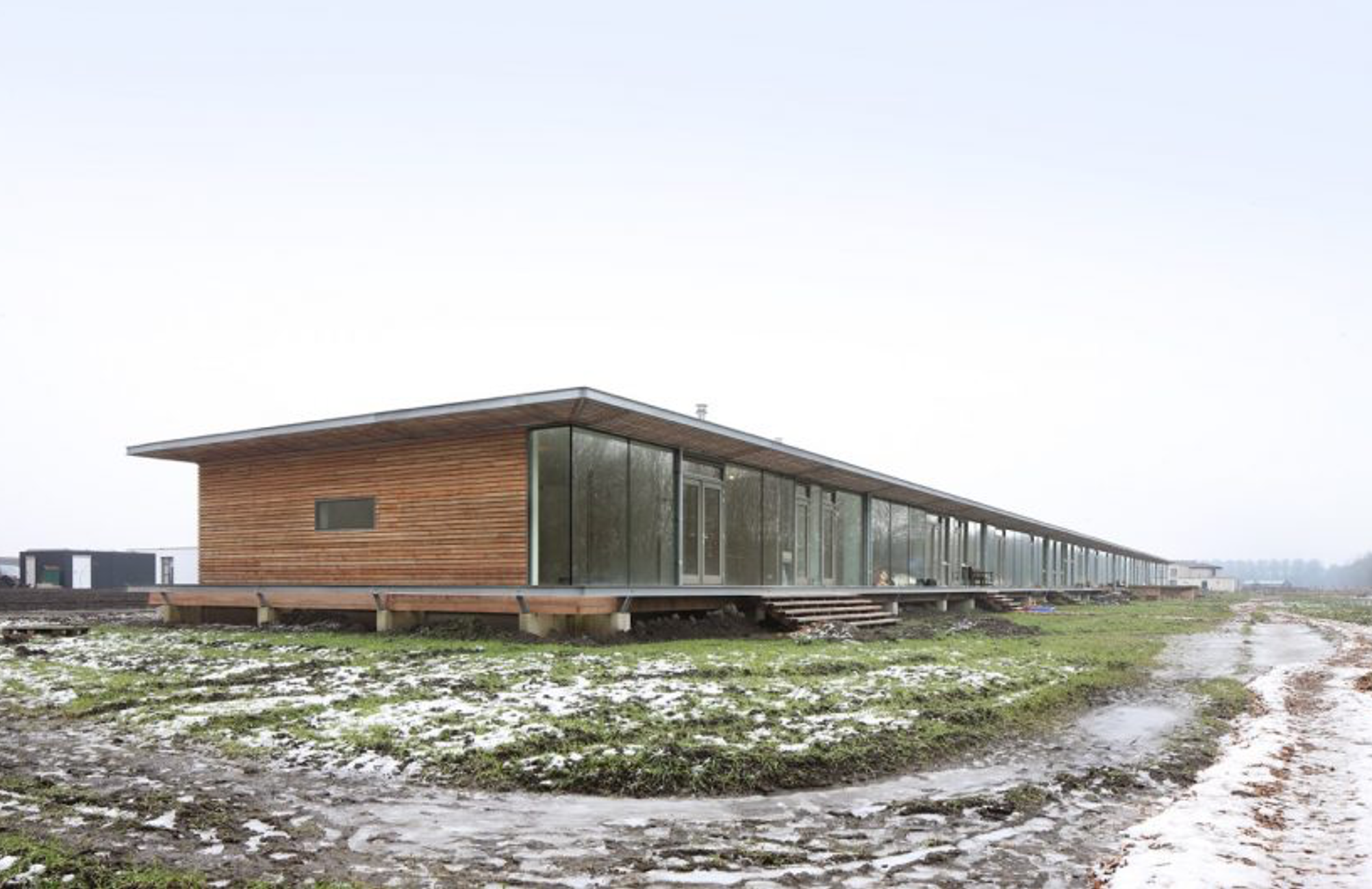Self-Organisation in a New Dutch Suburb: Housing development in Oosterwold
Created on 20-11-2023 | Updated on 21-11-2023
The greenfield site of Oosterwold in the Netherlands encompasses a development strategy spanning 43 square kilometres near the town of Almere. It is grounded in the principles of "organic area development," where there is no predetermined master plan; instead, it relies on a framework that includes land-use rules. This experimental approach, also known as “do-it-yourself urbanism,” empowers residents to develop their own site and collectively decide about the design and management of various infrastructural components, such as roads, waste and water management, energy supply, and green communal spaces. However, the experimental and self-organised planning approach has led to a proliferation of privately-owned housing, and to a notable underdevelopment in social and affordable housing.
Planner(s)
MVRDV , Municipality of Almere
Area
Almere, Netherlands
Project (year)
2011- To date
Construction (year)
2011
Housing type
Single-housing, multifamily housing, collective housing
Amenities
Shops, grocery stores, schools
Object of study
Urban plan Urban regulation
Description
The Oosterwold greenfield site in the Netherlands, spanning 4,300 hectares near the town of Almere, represents a well-documented example of large-scale self-organisation and urban development. Initially established as a Dutch New Town in the 1970s within the greater Amsterdam Metropolitan Area, Almere’s first phase of development embraced poly-nuclear, low-rise, and child-friendly neighbourhood plans, incorporating social housing and small-scale public amenities. Subsequent phases witnessed a shift towards more rational and uniform urban plans, characterized by market-led housing development, taking advantage of its proximity to Amsterdam amid urban growth in the 20th century. In 2006, a new council looked for alternatives to large-scale housing production, leading to the sale of municipally owned plots to individual households. Further programmes to financially support the private and collective commissioning of affordable housing were later introduced in partnership with the housing corporation Alliante. After the 2008 financial crisis, Almere’s approach to suburban housing began to shift towards enabling participation and self-organisation by citizens, with principles of active citizenship playing a prominent role (Boonstra, 2015).
The ongoing development of the Oosterwold area represents the latest and most experimental urban extension community built on greenfield land. This initiative has provided Almere’s municipality with an opportunity to further explore the liberalisation of planning and housing development by selling land to individuals, housing associations and professional developers. It is being implemented as an “organic area development”, meaning that there is no predetermined master plan, only experimental land use rules related to the division of space. These rules encompass various aspects such as the division of space according to use categories, terms of energy production, sanitation and floor area ratios. For example, the rules stipulate the ratio between buildable land, urban farming and publicly accessible green areas per plot. This type of plot-by-plot ratio approach encourages the realization of a distinctive urban-agricultural lifestyle. This experimental approach, also referred to as “do-it-yourself urbanism”, not only empowers residents to construct on their own plots (unconventional for Dutch norms), but also, unconventionally, allows them to collectively decide the design and management of other infrastructural components such as roads, waste management, water management, energy supply and green spaces in communal land (MVRDV, 2022).
Thanks to this innovative arrangement of co-production of services, plots were offered at rates which were lower than market value, providing citizens with an opportunity to integrate agriculture with housing. In Oosterwold, active citizens organized themselves and share responsibility with the government in delivering public services, such as the management of water facilities, which would otherwise fall under complete government control (van Karnenbeek et al., 2021). The variety of built residential projects is vast. Some residents were attracted to Oosterwold because they were interested in living off the grid, starting with as little as a camper van and expanding outwards. Another project involves a 100 m long co-living building designed for a group of friends, horizontally connected in a row of units of 160 square meters each. To connect the diverse shapes and sizes of structures with public infrastructure such as roads and wastewater, a high level of community participation and self-organisation was required.
A dedicated website provides information for potential dwellers, including an initial letter of intent, options to collaborate with neighbours to set up an association to build the access road, the submission of a development plan, obtaining an environmental permit, and other responsibilities entrusted to the “initiator” of a housing initiative. The initiators can be individuals, cooperatives or real estate developers capable of producing housing at either market or affordable costs. The processes of collective decision-making and collaborative governance are monitored by numerous neighbourhood organizations already active in Oosterwold, discussing among other topics the need for more affordable housing. Consultation meetings, involving residents, local farmers, developers, utility companies, and municipality officials, are held regularly.
Cozzolino et al. (2017, p. 55) explain that the framework-rules allow for “greater use of dispersed knowledge”, indicating a high degree of flexibility. However, this flexibility raises concerns about the potential for the public agency to operate in a discretionary manner, especially regarding rule interpretations and agreements between private initiators and the municipality at the local scale (Cozzolino et al., 2017). Addressing debates surrounding the notion of localism, and considering the selectiveness of policies supporting self-organisation and active citizenship, there is a danger of new forms of exclusivity emerging. The Dutch Wijkaanpak, meaning “neighbourhood approach”, is criticized by Savini (2016) who explains how “self-organization may undermine the capacity of public governments to balance increasing socio-economic inequalities across city-regions and to sustain exclusionary and selective practices of spatial appropriation” (p. 1153). This way, under the guise of increased freedom in planning, plan-led development by the state can be replaced with neoliberal, property-led development (Chevalier & Tzaninis, 2022). Furthermore, such endeavours tend to need more time and higher levels of expertise, which attracts private actors with higher economic and social capital rather than low-income residents (Levelt & Tan, 2023). Finally, other authors criticize the incremental approach of self-organised wastewater management in Oosterwold for jeopardising environmental standards (van Karnenbeek et al., 2021)
Nonetheless, despite the increasing development of privately-owned housing and the underdevelopment of social housing (Van Straalen et al., 2017), the Oosterwold way of planning has facilitated some cohousing projects and those by larger developers that prioritize open space and agriculture while minimising the square meters of living areas. For instance, projects such as 't Groene Wold by the developer Vastbouw integrate sustainability and the Oosterwold framework of urban agriculture, water collection and public facilities while providing about 70% of rental properties in the affordable segment. Additionally, the co-production of public services in Oosterwold, which could also be considered as common-pool resources, represents a real-life experiment in social infrastructure, public services, and housing provision simultaneously. Direct citizen engagement in Oosterwold, involving decisions about land use and the planning of services, such as wastewater and energy production, is an innovative approach to neighbourhood development and urban governance. While not without expected challenges, especially concerning the need to consolidate infrastructural components, this more flexible project-based planning has created opportunities to test various housing typologies and open space layouts that can grow incrementally and also diffuse initial housing costs.
The primary focus of this case study is the incremental and experimental civic-led urban development strategy implemented in residential greenfield sites. When analysing urban developments characterized by increased self-governance and self-organisation in planning, the project’s scale, ranging from the plot to the district level, becomes a decisive factor (Rauws, 2016). This highlights the imperative for planning experiments at the neighbourhood level , specifically addressing the provision of affordable housing. Starting from the individual plot and expanding with a do-it-yourself ethos to the level of community self-organisation, these experiments in urban growth have the potential to challenge the market-dependent institutions of housing development. They can achieve this by establishing collaborative governance arrangements between local government and civil society organisations.
Alignment with project research areas
Design, planning and building:
The Oosterwold case exemplifies an alternative, sustainable planning strategy, aligned with the research area of design, planning and building. It stands out as an atypical instance of greenfield development due to its substantial size and the experimental, innovative nature. Comprising a mix of land uses, its primary components include residential buildings and sustainable agriculture. Despite being a low-density area, Oosterwold places a significant emphasis on the use of renewable energy and food resources at the neighbourhood/district level.
Community participation:
The concept of citizen self-organisation in Oosterwold stems from the paradigm of participatory/community planning. It represents one of the most extreme cases of active citizenship, as the open-ended strategy requires residents to assume planning roles traditionally held by local government. The entire Oosterwold scheme sets a distinct trajectory within the well-regarded context of Dutch, state-driven planning. It favours the sharing of knowledge among stakeholders involved, experts and non-experts, encourages private initiatives, and promotes greater flexibility in regulation, leading to an organic distribution of land uses driven by the demands of the initiators.
Policy and Financing:
This planning experiment has the potential to shape new policies addressing the interdependencies among housing, self-organisation, collaborative governance, and energy and food production in urban development.
* This diagram is for illustrative purposes only based on the author’s interpretation of the above case study
Alignment with SDGs
Oosterwold responds to the following Sustainable Development Goals (SDGs):
- Goal 3 Good health and well-being: It provides healthy living, outdoor urban farming work and connections to nature
- Goal 7 Affordable and clean energy: Solar energy, heat pump systems, grey water circuits are included in most buildings
- Goal 11 Sustainable cities and communities: It is an innovative urban planning experiment aimed at promoting sustainable land use and land management, integrating environmental infrastructure provision, and ensuring adequate shelter for all. However, the latter aspect requires more attention, given the current emphasis on sustainability over affordability.
References
Boonstra, B. (2015). Planning strategies in an age of active citizenship: A post-structuralist agenda for self-organization in spatial planning. InPlanning.
Chevalier, D., & Tzaninis, Y. (2022). Planning utopia. In Utopian Thinking in Law, Politics, Architecture and Technology: Hope in a Hopeless World (pp. 208–226). Edward Elgar Publishing.
Cozzolino, S., Buitelaar, E., Moroni, S., & Sorel, N. (2017). Experimenting in urban self-organization: Framework-rules and emerging orders in Oosterwold. Cosmos + Taxis, 4(2), 49–59.
Levelt, M., & Tan, W. (2023). A paradoxical transition of citizen participation in housing developments. In InPlanning. https://doi.org/10.17418/TIP.2023.ART.01
MVRDV. (2022). ALMERE OOSTERWOLD. https://www.mvrdv.com/projects/32/almere-oosterwold
Rauws, W. (2016). Civic initiatives in urban development: Self-governance versus self-organisation in planning practice. Town Planning Review, 87(3), 339–361. https://doi.org/10.3828/tpr.2016.23
Savini, F. (2016). Self-Organization and Urban Development: Disaggregating the City-Region, Deconstructing Urbanity in Amsterdam. International Journal of Urban and Regional Research, 40(6), 1152–1169. https://doi.org/10.1111/1468-2427.12469
van Karnenbeek, L., Salet, W., & Majoor, S. (2021). Wastewater management by citizens: mismatch between legal rules and self-organisation in Oosterwold. Journal of Environmental Planning and Management, 64(8), 1457–1473. https://doi.org/10.1080/09640568.2020.1829572
Van Straalen, F. M., Witte, P., & Buitelaar, E. (2017). Self-Organisation in Oosterwold, Almere: Challenges with Public Goods and Externalities. Tijdschrift Voor Economische En Sociale Geografie, 108(4), 503–511. https://doi.org/10.1111/tesg.12267
Related vocabulary
Collaborative Governance
Area: Community participation
Created on 26-10-2023
Read more ->



